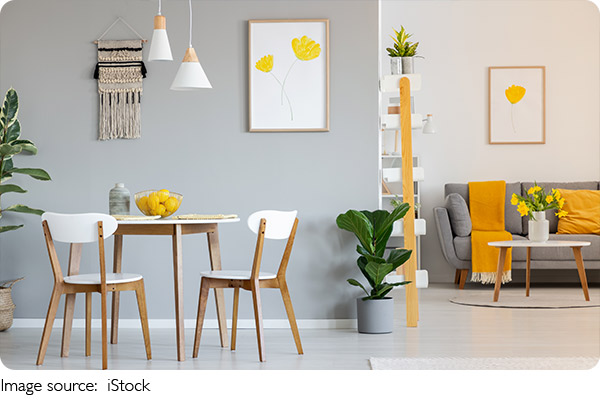Style Meets Comfort

Matching soft décor to your preferred interior design style isn't always easy. The wrong curtain pattern, an overly bold pillow color, or a mismatched rug can throw the entire look off balance. But when it's done right?
Your space feels cohesive, inviting, and distinctly you. Whether you love minimalist calm or vintage charm, this guide will walk you through examples of soft décor styling across different design genres—so you can get it right every time.
What Is Soft Décor?
Soft décor refers to non-structural elements in interior design made of textiles or pliable materials. Think curtains, cushions, rugs, throws, bed linens, and even upholstered furniture. These items offer flexibility to refresh or reimagine a space without major renovations.
The beauty of soft décor lies in its power to transform. A simple velvet throw can turn a cold leather sofa into a cozy reading nook. Likewise, airy linen drapes can bring lightness and motion to an otherwise heavy space.
Scandinavian Style: Soft and Serene
Scandinavian interiors emphasize light, simplicity, and function. The color palette typically leans toward whites, soft grays, and muted earth tones.
Soft décor elements to match:
• Neutral linen or cotton curtains to allow natural light.
• Chunky knit wool throws for texture and warmth.
• Cushions in minimalist geometric patterns or solid muted colors.
• Rugs in light tones—often wool or cotton with simple weaves.
Expert tip: Designer Anya Eliassen recommends layering white on beige with subtle textures to avoid a sterile feel. Use different fabric finishes—matte, nubby, or lightly brushed—for depth.
Bohemian Style: Vibrant and Eclectic
Bohemian interiors are all about creativity, warmth, and rich expression. There's often a colorful mix of global-inspired patterns, plants, and vintage finds.
Soft décor elements to match:
• Moroccan or Persian-style patterned rugs.
• Multicolored cushions in velvet, silk, or embroidered fabric.
• Macramé wall hangings or tasseled throws.
• Sheer curtains in jewel tones like turquoise or saffron.
Styling idea: Mix and match different textile cultures—like a Moroccan kilim rug with a Mexican serape throw—to create a curated, traveled look.
Modern Minimalist: Less Is More
Minimalism focuses on simplicity, clean lines, and function-first design. In such spaces, soft décor plays a critical role in softening the starkness.
Soft décor elements to match:
• Monochromatic cushion sets in black, gray, or white.
• Low-pile rugs in solid tones or subtle textures.
• Streamlined curtains in structured cotton or lightweight wool.
• Avoid excessive embellishment; go for precision and quality.
Expert insight: Interior stylist J. Chan suggests using no more than three textile types in a minimalist room to maintain clarity and reduce visual noise.
Vintage or Retro Style: Nostalgic and Cozy
Vintage-inspired spaces draw from past decades—1950s florals, 1970s earth tones, or 1980s pastels. Texture and character are key.
Soft décor elements to match:
• Quilted throws or handmade patchwork blankets.
• Floral-print cushions or retro pattern covers.
• Velvet or corduroy upholstery on armchairs.
• Curtains with scalloped trims or lace edging.
Practical note: If you're buying vintage fabrics, ensure they're in good condition or get them professionally cleaned before use.
Industrial Style: Rugged Meets Refinement
This style often features raw elements like exposed brick, metal piping, and distressed wood. Soft décor helps balance the hardness with comfort.
Soft décor elements to match:
• Woven leather or faux-leather cushions.
• Heavy wool or jute rugs in dark neutrals.
• Canvas curtains with metal grommets.
• Denim or herringbone-textured throws.
Bonus idea: A rugged leather pouf or beanbag can double as casual seating and a strong visual statement.
Coastal or Mediterranean: Breezy and Bright
This look reflects beachside living—calm, sunlit, and open. Think of soft ocean blues, sandy whites, and natural textures.
Soft décor elements to match:
• Sheer white or pale blue linen curtains.
• Nautical-striped cushions or rope-accented pillows.
• Jute or sisal rugs for a sandy texture.
• Light cotton throws with fringe or tassel details.
Designer recommendation: Use washable fabrics in these settings since they're often exposed to sunlight and salt air.
Japanese Zen Style: Calm and Intentional
Zen interiors are centered on balance, harmony, and mindfulness. The color palette is soft and grounded, with emphasis on natural materials.
Soft décor elements to match:
• Tatami-inspired woven mats.
• Floor cushions in neutral canvas.
• Shoji-style fabric panels instead of traditional curtains.
• Cotton throws in soft earth tones—taupe, olive, beige.
Tip from experts: Keep clutter to a minimum. Every fabric should have a purpose, not just decoration.
Transitional Style: Balanced and Timeless
A blend of traditional elegance and contemporary simplicity, transitional design works best when the soft décor is subtle yet refined.
Soft décor elements to match:
• Tailored curtains in mid-weight fabrics like cotton-silk blend.
• Velvet or chenille cushions in solid colors.
• Low-pile neutral rugs with minimal patterns.
• Layered throws in a tonal palette for depth.
Advice: Pay attention to symmetry—place cushions or drapes in pairs or even numbers for balance.
Practical Tips for Matching Styles
• Stick to a color scheme. Choose 2–3 dominant colors for each room and coordinate fabrics around them.
• Vary textures but keep a theme. For example, a modern space can include both matte and glossy fabrics, as long as the palette remains consistent.
• Sample first. Always test fabric swatches in your room's actual lighting.
• Quality over quantity. Invest in fewer, better pieces rather than crowding your space with mismatched textiles.
Make Your Style Personal
While guides and rules are helpful, your home should ultimately reflect you. Don't be afraid to blend styles if that's what brings you joy. A Boho cushion in a minimalist room? Go for it. A velvet throw on a coastal couch? If it feels right, it is right.

Soft décor has the unique ability to unify or elevate your interior design. Once you understand how each style interacts with fabric, pattern, and placement, you can confidently decorate any room with taste and harmony.
What's your personal design style? Are you a mix-and-match type or do you stick to a single theme? Share your thoughts—we'd love to hear how you express your home through soft décor!
-
 Ancient Sea SecretsDiscover How a 506-Million-Year-Old “Three-Eyed Sea Monster” Unlocks the Secrets of Modern Arthropods’ Evolution!
Ancient Sea SecretsDiscover How a 506-Million-Year-Old “Three-Eyed Sea Monster” Unlocks the Secrets of Modern Arthropods’ Evolution! -
 Ecuador DishesTaste Your Way Through Ecuador! Discover the Dishes, Souvenirs, and Secrets Locals Love
Ecuador DishesTaste Your Way Through Ecuador! Discover the Dishes, Souvenirs, and Secrets Locals Love -
 Clawed Jungle MysteryThis Dinosaur Bird Still Exists—And It Smells Like Rotten Salad!
Clawed Jungle MysteryThis Dinosaur Bird Still Exists—And It Smells Like Rotten Salad!